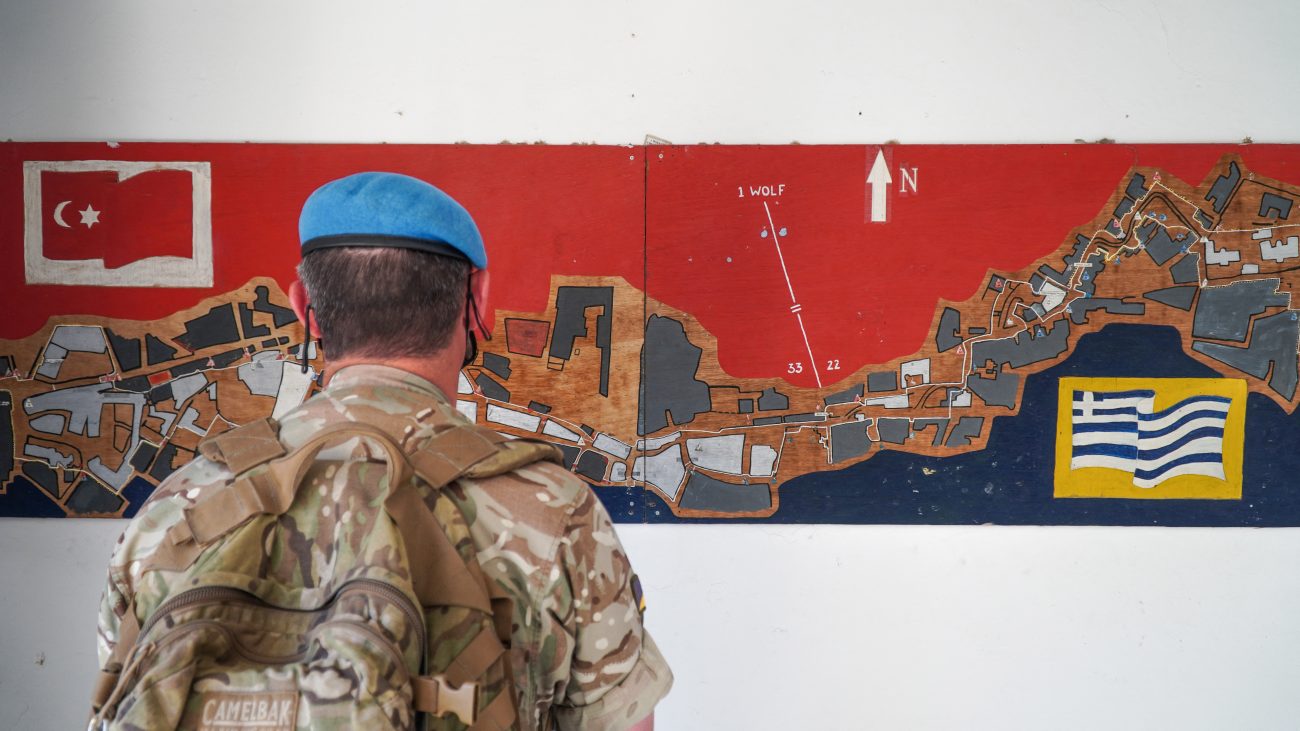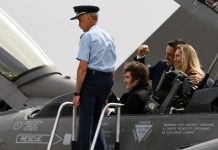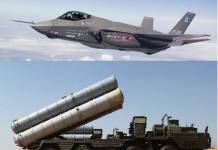Marking the 51st anniversary of Turkey’s invasion of Northern Cyprus, Turkish President Recep Tayyip Erdogan reiterated calls for a ‘two-state solution’ of the island country, which is fiercely opposed by the Republic of Cyprus and Greece.
“Our support for (Turkish Cypriot leader Ersin Tatar’s) vision for a two-state solution is absolute,” Turkish President Recep Tayyip Erdogan told the crowd that had assembled to celebrate the occasion that ended with a military parade. “It is time for the international community to come to terms with the facts on the ground,” Erdogan added.
Turkey invaded Northern Cyprus on July 20, 1974, in the wake of a Greek coup by the military junta backed by Greek Cypriot militants (EOKA-B), which was aimed at uniting Cyprus with Greece. Turkey occupied nearly 36% of northern Cyprus territory, the coup collapsed, and constitutional order was restored in the south of the island state. However, Turkey retained control of the north, leading to the island’s de facto partition.
In 1983, Turkish Cypriots declared the “Turkish Republic of Northern Cyprus” (TRNC) in the occupied north. The territory has since remained under Turkey’s occupation. On the 51st anniversary of the invasion, the Turkish President called on the international community to establish diplomatic and economic ties with the breakaway state.
The TRNC has no legal validity and is not recognized by any other state. The United Nations has made several attempts to persuade Turkey to permit the establishment of a unified federal government in Cyprus with a single sovereignty. However, the repeated calls for a two-state solution from the TRNC and the Turkish government have scuttled the formal negotiations between the Turkish and Greek Cypriots.
Despite being NATO allies bound by a mutual defense clause, Turkey and Greece have a historical rivalry rooted in ethnic and territorial disputes, particularly in the Aegean and Eastern Mediterranean seas. The Cyprus issue, however, remains the most significant source of friction between the two countries.
Interestingly, Erdogan’s public endorsement of the ‘two-state’ solution came days after the foreign ministers of “guarantor” nations Greece and Turkey, Turkish Cypriot President Tatar, the Greek Cypriot President Nikos Christodoulides, and Britain’s minister of state for Europe convened at the UN headquarters in New York to meet with US Secretary-General Antonio Guterres to lift an eight-year ban on formal peace talks.
As a precondition, Tatar demanded recognition for the breakaway Turkish Cypriot state, which has once again held up any meaningful progress toward a return to full-fledged negotiations.
However, the Secretary-General said that the summit did make some headway on several steps aimed at fostering confidence, including the creation of an advisory group on civil society and the sharing of cultural relics.
The UN Secretary-General said he will reconvene with Tatar and Christodoulides in September and have a more extensive discussion following the October Turkish Cypriot leadership election, in which Tatar is competing on the platform of a two-state solution.

What Is The Cyprus Issue Between Turkey & Greece?
Cyprus, a Mediterranean island, was under Ottoman Empire control until 1878. It was annexed by the British in 1914 and later governed as a crown colony.
The demography of this island state was people of both Greek and Turkish origin, with Greek Cypriots making up the majority of the island’s population and Turkish Cypriots the minority, which influenced their respective politics.
The Greek Cypriots, for one, sought unification with Greece, whereas the Turkish Cypriots favored partition or continued British rule to avoid Greek dominance.
In the 1950s, there was widespread discontent among the majority Greek Cypriot population against British rule, which triggered violence across the country.
This eventually paved the way for Cyprus’ independence through the Zurich-London Agreements of February 1959. Cyprus became an independent republic on August 16, 1960, with the establishment of the Republic of Cyprus as a bicommunal state featuring a power-sharing constitution between Greek and Turkish Cypriots.
According to this arrangement, Greece, Turkey, and the UK were designated as guarantor powers under the Treaty of Guarantee, with the right to intervene to maintain the constitutional order.
Greek & Turkish Cypriots were supposed to share power as two political equals, which included jointly being responsible for the law-making functions of the newly independent state. However, due to the stark difference in population between the two communities, the constitution remained fragile, and the two sides became disillusioned.
There was discontent among Greek Cypriots regarding issues such as power sharing and the perceived disproportionate participation of Turkish Cypriots in government, as well as the veto privileges granted to them. In 1963, the then-Greek Cypriot President Makarios proposed constitutional amendments to centralize power.
However, the Turkish Cypriots rejected these revisions, fearing exclusion and marginalization at the hands of the majority government. This led to communal violence, known as “Bloody Christmas,” and the withdrawal of Turkish Cypriots from the government.
“The Greek Cypriots, in conspiracy with Greece, launched a violent campaign for annexing the Island to Greece in 1955. The terrorist organization EOKA, under the guidance of Archbishop Makarios, indiscriminately murdered everyone in their way, the British (the then colonial rulers), the Turkish Cypriots, and even some of their kinsmen, who were opposed to the idea of “Enosis,” states the official website of the Turkish Ministry of Foreign Affairs.
After the Turkish Cypriots left the government, the state of affairs in the Mediterranean country deteriorated, and on 15 July 1974, a Greek military junta backed a coup led by the Cypriot National Guard to achieve enosis (unification with Greece), overthrowing the democratically elected government led by Greek Cypriot President Makarios.
The deposed President Makarios successfully escaped Cyprus via Paphos. They reached New York, where he spoke on July 19 and denounced the coup and the plan to unite his democratic and sovereign nation with Greece.
By this time, Turkey was fully apprised of the situation, which it saw as a threat to the existence of Turkish Cypriots. Therefore, a military plan was devised to land in northern Cyprus, engage the National Guard, and halt the Enosis.
The official website of the Cyprus Ministry of Foreign Affairs states, “The coup staged by the Athens junta against the elected government of President Makarios on July 15, 1974, served Turkey as a pretext to impose its divisive plans against Cyprus.”

On the morning of 20 July 1974, sirens sounded across Cyprus, signalling that the invasion was underway. Turkish military troops landed boots on the ground in Kyrenia, north of Cyprus, while Ankara’s air forces launched an aerial assault campaign on multiple targets on the island, causing massive destruction and suffering.
After a month of fighting between the Turkish Cypriots and the Greek junta forces and Greek Cypriot militias, Turkey occupied about 36% of the Northern Cyprus territory.
The invasion led to the deaths of more than 3,000 people, mainly civilians. It displaced approximately hundreds of thousands of Greek Cypriots from the north and forced many Turkish Cypriots to relocate to the north from the south.
However, Turkey still maintains that its military operation, code-named “Operation Attila,” was a non-combative intervention meant to preserve the nation’s Turkish Cypriot minority and restore constitutional order rather than an invasion. It reasons that while the world remembers the events of July 20, 1974, it has blissfully forgotten the fifteen years before it that marginalized the Turkish Cypriots.
Only Turkey recognises the island’s breakaway state in northern Cyprus, which is repeatedly denounced by the international community, including the United Nations and the European Commission of Human Rights.
According to reports, Turkey’s policy of settling Turkish nationals in the north aimed to alter the demographic balance, which the Republic of Cyprus condemns as a violation of international law.
Turkey stations between 30,000 and 43,000 troops in Northern Cyprus, making it one of the densest military presences per capita in the region.
Fifty-one years later, Turkey continues to maintain several military bases, including army garrisons, airfields, and naval facilities. The main base is located near Kyrenia (Girne), with additional outposts across the TRNC. The Turkish Air Force and Navy regularly patrol the region, supported by radar and surveillance systems.
Additionally, Turkey’s military supports exploration and drilling in waters claimed by Cyprus, which are also contested. This has led to an escalation in tensions not only between Cyprus and Turkey but also between Turkey and Greece.
Over the years, the UN has made sincere efforts to mediate talks between the two sides, aiming to arrive at an amicable solution to the Cyprus issue. Notably, the last peace talks between the Greek and Turkish Cypriots fell apart in 2017 when Greek Cypriots demanded the withdrawal of Turkish troops and the abolition of Turkey’s guarantor status, a demand that was sternly opposed by Turkey and Turkish Cypriots.
The internationally recognized Greek Cypriot-led Republic of Cyprus seeks a bizonal, bicommunal federation with a single sovereignty, citizenship, and international personality, in compliance with UN resolutions and EU principles. However, the TRNC endorses the recognition of a breakaway Cyprus state through a two-state solution.
For Turkish President Erdogan, control over Cyprus is part of a larger strategy to expand Turkish influence. However, this reluctance to settle the dispute and consolidate power under the Cyprus government has led to a perpetual stalemate in the country.
- Contact the author at sakshi.tiwari9555 (at) gmail.com
- Follow EurAsian Times on Google News




